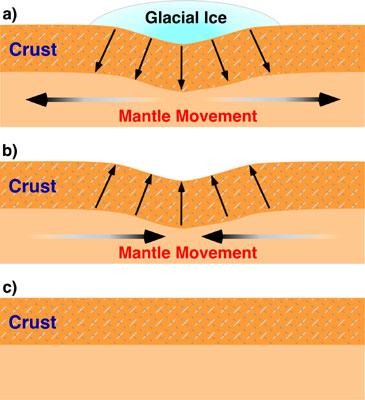Lake Bonneville was an enormous closed lake (meaning it had no outlet) encompassing the western half of Utah during the Pleistocene. The Great Salt Lake is a small remnant. It would be among the few largest, deepest, and highest lakes today. When its level raised to 1500 m above sea level at the end of the last glaciation, 15,000 years ago, its waters found an exit through the Red Rock pass and the lake was suddenly drained. It produced one of the largest floods ever recorded: the Bonneville Flood (see this previous post). But there was another consequence to the flood: When the lake water was released, the lithosphere under the lake moved upwards to readjust its isostatic equilibrium with the viscous mantle that underlies the Earth's crust.
Now, do you believe this story?
If you are skeptic and you feel unsatisfied by the extensive scientific literature on isostasy accumulated ever since, you can use Google Earth to see it by yourself. Pay attention to the elevation of these two preserved shorelines at two locations 1) in the margins of Lake Bonneville (left) and 2) at the center of it (right):
| Lake Outlet. Shoreline altitude: 1510 m | Lake Center. Shoreline altitude: 1590 m |
Just in case this is not obvious to you. The shorelines are the abrupt changes in slope produced either by the deposition of materials brought by streams when they where reaching the lake, or by the erosion of the lake waves along the coast.
Both shorelines record the maximum level of the same lake, but the one in the center of the lake is today 80 m higher. The uplift implied for the central areas of the Bonneville Lake was a lithospheric response to the unload of water during the Bonneville Flood and the desiccation of the lake thereafter.
donkey. Plus, he also performed numerical modeling (yes, in 1890, really) to test his interpretations with physical laws. He even could estimate the strength of the crustal plate sustaining the lake, a concept that would still take some 70 years to become standard: Flexural isostasy.
If geniuses would exist, then Gilbert would be one of them. His report "Lake Bonneville" (download) was revolutionary for two reasons: It showed the first model of flexural isostasy, and the first confirmation of isostatic vertical motions in a lake setting. But secondly, it provided geomorphological evidence for a huge flood (a débacle) that challenged the principle of uniformitarianism.
I thus ow these words to Gilbert since I first hold his 130 years-old book in a basement of the ANU, in Canberra. It opened my eyes to a geological-scale tragedy: the century-long wait for the geological establishment to listen to both ideas: isostasy and megaflooding. It took them that long because those ideas were at odds with the Principles of Geology. But principles should remain just tools, not goals!
More information:
G, K, Gilbert (1890). Lake Bonneville USGS Reports DOI: 10.5962/bhl.title.45550 Lake Bonneville fluctuations and global climate change. (1997).
Oviatt, Charles G. Geology, 25 (2) DOI: 10.1130/0091-7613(1997)025
Watts, A. B. (2001). Isostasy and flexure of the lithosphere. Cambridge: Cambridge univ. press. Introduction pdf available.
Billis et al., 1994, JGR v.99
J. E. O'Connor (1993). Hydrology, Hydraulics and Geomorphology of the Bonneville Flood GSA Special Paper, GSA, Boulder, CO, , 274 DOI: 10.1002/(SICI)1099-1417(199609/10)11:5
[update: recent review paper on isostasy]



Really interesting! 80 mts in 15ky, this seems to me to be a lot. Such an uplift should be related with new erosion(and deposition)features. Do you see any of them?
ReplyDeleterelated how? But anyway we are talking about 80 mts over distances of a hundred km. Plus, most of the uplift took place over the first ~5 ky after overflow
DeleteThis comment has been removed by the author.
ReplyDeleteThis comment has been removed by a blog administrator.
ReplyDelete